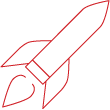We nurture curious and creative minds to thrive in the ever-changing media and communication professions. Our inclusive “do from day one” experience is rooted in hard work, collaborative problem-solving and the ethical pursuit of truth to uphold democracy.
To be a national leader in experiential journalism and mass communications education.
Our students do from day one: We live and breathe experiential learning. Every student engages in hands-on, industry-centric experiences in and out of the classroom to create a professional portfolio unique to their strengths, experiences and career aspirations.
We solve real problems: We value diversity of people and ideas to foster creativity and collaborative problem solving. We are committed to advancing our fields through research and creative activity.
We believe in hard work: Our work ethic is paramount to our success. Grounded in research and critical thinking, our curriculum is rigorous and challenging to prepare students for demanding professions.
We pursue truth: The First Amendment gives us the ultimate responsibility to serve the needs of our diverse and democratic society. We pursue truth and report it fairly. We tell genuine stories with transparency and integrity.
We nurture curious and creative minds: We exist to educate and empower media and communication professionals of tomorrow. Every decision, measure and outcome is based on how well it serves our students and educational purpose.
We are an inclusive community: All are welcome here. We respect the dignity of humanity and advocate for social justice. We are committed to diversity, equity and inclusion. We care for and encourage each other as we work together to create a better future.
Our professions are ever-changing: We prepare students to build careers that will grow and change with our industries by pairing foundational skills with cutting-edge technology and innovative media applications. Our graduates are able to evolve with the changing media landscape.
Our graduates thrive: Our alumni are engaged in every sector of the media and communication industries. They are ethically grounded and globally-minded leaders, creators, strategists and storytellers who live and work around the corner and around the world.
Overview
In August 2020, the College of Journalism and Mass Communications launched a strategic planning process to lay the groundwork for the future of the college. Faculty and staff met for the fall retreat to discuss the state of higher education and our industries, competition, university and college. We identified trends, gaps, opportunities, questions, concerns and insights on our environment. Faculty and staff were surveyed to determine our purpose, collective strengths, opportunities and aspirations.
Building on this foundation, 78 college stakeholders, including 48 faculty and staff, nine current students and 21 alumni and industry partners were asked to engage in an expansive and inclusive strategic planning process. Stakeholders were assigned to seven task forces specific to mission, vision and values; external operations; people and internal operations; undergraduate academic operations; graduate academic operations; scholarship and creative activity; and student experiences and experiential learning. A review committee composed of alumni and emeritus faculty was established to provide feedback on the distinctive capabilities, strategies, action steps and measures drafted by each of the task forces.
Over the next six months, the task forces presented draft plans, and all committee members were invited to comment during the meetings and provide feedback anonymously online. Each iteration was also posted to the college website and shared through the alumni newsletter, encouraging alumni to provide comments and suggestions through the online feedback form. The review committee summarized the comments and feedback and recommended revisions.
In April 2021, the task force co-chairs met to review each task force action plan and identify strategic aims that would direct the college for the next five years. These aims, dubbed “game changers,” embraced our distinctive capabilities, aligned with our values, drove our mission and would help us realize our vision.
The strategic planning committee co-chairs drafted a plan around the aims and in line with the University of Nebraska-Lincoln N2025 Strategic Plan. Aims were aligned with our value statements and targets were determined by the dean and director of business and operations. The plan was presented to the full strategic planning committee on May 7, 2021, and approved by the college faculty and staff on May 14, 2021.
During the 2023-2024 academic year, the strategic planning committee proposed updates to the college’s strategic plan to address evolving circumstances since its initial adoption. These amendments were approved by the college's faculty and staff on September 13, 2024.
Aims

Launch a college-wide experiential learning lab

Help solve challenges critical to our industries

Advance the field by bridging research and practice in our graduate programs

Prioritize community building that recognizes, respects and celebrates diversity

Emphasize and prioritize research and creative activity across the college

Establish a culture of life-long learning and professional development

Embrace and protect the ethical pursuit of truth to uphold democracy

Create a robust alumni, donor and community engagement program
Our Plan
Aim 1: Launch a college-wide experiential learning lab
| Our students do from day one: We live and breathe experiential learning. Every student engages in hands-on, industry-centric experiences in and out of the classroom to create a professional portfolio unique to their strengths, experiences and career aspirations. | |
Strategies
| |
Expectations:
| 2025 Targets:
|
Aim 2: Advance the field by bridging research and practice in our graduate programs
| We believe in hard work: Our work ethic is paramount to our success. Grounded in research and critical thinking, our curriculum is rigorous and challenging to prepare students for demanding professions. | |
Strategies:
| |
Expectations:
| 2025 Targets:
|
Aim 3: Emphasize and prioritize research and creative activity across the college
Strategies:
| |
Expectations:
| 2025 Targets:
|
Aim 4: Embrace and protect the ethical pursuit of truth to uphold democracy
| We pursue truth: The First Amendment gives us the ultimate responsibility to serve the needs of our diverse and democratic society. We pursue truth and report it fairly. We tell genuine stories with transparency and integrity. | |
Strategies:
| |
Expectations:
| 2025 Targets:
|
Aim 5: Help solve challenges critical to our industries
| We nurture curious and creative minds: We exist to educate and empower media and communication professionals of tomorrow. Every decision, measure and outcome is based on how well it serves our students and educational purpose. | |
Strategies:
| |
Expectations:
| 2025 Targets:
|
Aim 6: Prioritize community building that recognizes and celebrates diversity
| We are an inclusive community: All are welcome here. We respect the dignity of humanity and advocate for social justice. We are committed to diversity, equity and inclusion. We care for and encourage each other as we work together to create a better future | |
Strategies:
| |
Expectations:
| 2025 Targets:
|
Aim 7: Establish a culture of life-long learning and professional development
| Our professions are ever-changing: We prepare students to build careers that will grow and change with our industries by pairing foundational skills with cutting-edge technology and innovative media applications. Our graduates are able to evolve with the changing media landscape. | |
Strategies:
| |
Expectations:
| 2025 Targets:
|
Aim 8: Create a robust alumni, donor and community engagement program
| Our graduates thrive: Our alumni are engaged in every sector of the media and communication industries. They are ethically grounded and globally-minded leaders, creators, strategists and storytellers who live and work around the corner and around the world. | |
Strategies:
| |
Expectations:
| 2025 Targets:
|
Task Forces
Mission, Vision, Values
- Shari Veil, co-chair
- Kaitlin Van Loon, co-chair
- Alex Fernando
- Gary Kebbel
- Barney McCoy
- Greg Andersen
- Madeline Wiseman
- Lyn Wineman
- Adam Kroft
- Regan Vaccaro
External Operations
- Jemalyn Griffin, co-chair
- Nicole Blackstock, co-chair
- Trina Creighton
- Chris Graves
- Anne McConkey
- Matt Boyd
- Deb Fiddelke
- Dylan De Vries
- Kellie Wostrel
People & Internal Operations
- Matt Waite, co-chair
- Haley Hamel, co-chair
- Rick Alloway
- Steve Blum
- Valerie Jones
- Jill Martin
- Tyler Thomas
- Paula Lavigne
- Tabitha Lincoln
- Jasmine Alexander
Undergraduate Academic Operations
- Adam Wagler, co-chair
- Andrea Gaghagen, co-chair
- Kelli Britten
- Tiffany Groteluschen
- Amy Ort
- Luis Peon-Casanova
- Kaci Richter
- Jenn Sheppard
- Bruce Thorson
- Cody Frederick
- Chad Davis
- Caelan Debban
Graduate Academic Operations
- Joe Weber, co-chair
- Carly Morse, co-chair
- Monique Farmer
- Laurie Lee
- Olga Pierce
- Bryan Wang
- Lauryn Higgins
- Mike Reilley
Scholarship & Creative Activity
- John Bender, co-chair
- Bridgett Grant, co-chair
- Michelle Hassler
- Dane Kiambi
- Katie Krcmarik
- Maria Marron
- Joe Starita
- Changmin Yan
- Lyle Denniston
- LaSharah Bunting
- Chelsea Hampton
Student Experiences & Experiential Learning
- Frauke Hachtmann, co-chair
- Kris Scanlon, co-chair
- Alan Eno
- Jessica Fargen-Walsh
- Susan Oestmann
- Vance Payne
- John Shrader
- Allen Vaughan
- Kelly Mosier
- Emily Morrow
- Paige Heinemann
External Review
- Sandy Dose
- Margaret Holman
- Mary Garbacz
- Steve Jordon
- Nancy Mitchell
- Harry Argue
- Phyllis Larsen
OUR PLAN
You can download a pdf copy of the College of Journalism and Mass Communications' Strategic Plan using the button below.